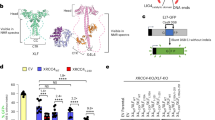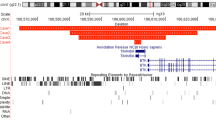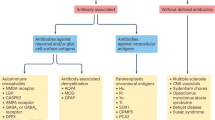Abstract
The repair of DNA double-stranded breaks (DNAdsb) through non-homologous end joining (NHEJ) is a prerequisite for the proper development of the central nervous system and the adaptive immune system. Yet, mice with Xlf or PAXX loss of function are viable and present with very mild immune phenotypes, although their lymphoid cells are sensitive to ionizing radiation attesting for the role of these factors in NHEJ. In contrast, we show here that mice defective for both Xlf and PAXX are embryonically lethal owing to a massive apoptosis of post-mitotic neurons, a situation reminiscent to XRCC4 or DNA Ligase IV KO conditions. The development of the adaptive immune system in Xlf−/−PAXX−/− E18.5 embryos is severely affected with the block of B- and T-cell maturation at the stage of IgH and TCRβ gene rearrangements, respectively. This damaging phenotype highlights the functional nexus between Xlf and PAXX, which is critical for the completion of NHEJ-dependent mechanisms during mouse development.
Similar content being viewed by others
Log in or create a free account to read this content
Gain free access to this article, as well as selected content from this journal and more on nature.com
or
References
Sancar A, Lindsey-Boltz LA, Unsal-Kacmaz K, Linn S . Molecular mechanisms of mammalian DNA repair and the DNA damage checkpoints. Annu Rev Biochem 2004; 73: 39–85.
Jung D, Giallourakis C, Mostoslavsky R, Alt FW . Mechanism and control of V(D)J recombination at the immunoglobulin heavy chain locus. Annu Rev Immunol 2006; 24: 541–570.
Lieber MR . The mechanism of double-strand DNA break repair by the nonhomologous DNA end-joining pathway. Annu Rev Biochem 2010; 79: 181–211.
Gao Y, Sun Y, Frank KM, Dikkes P, Fujiwara Y, Seidl KJ et al. A critical role for DNA end-joining proteins in both lymphogenesis and neurogenesis. Cell 1998; 95: 891–902.
Frank KM, Sekiguchi JM, Seidl KJ, Swat W, Rathbun GA, Cheng HL et al. Late embryonic lethality and impaired V(D)J recombination in mice lacking DNA ligase IV. Nature 1998; 396: 173–177.
de Villartay JP, Fischer A, Durandy A . The mechanisms of immune diversification and their disorders. Nat Rev Immunol 2003; 3: 962–972.
Alt FW, Zhang Y, Meng FL, Guo C, Schwer B . Mechanisms of programmed DNA lesions and genomic instability in the immune system. Cell 2013; 152: 417–429.
Xing M, Yang M, Huo W, Feng F, Wei L, Jiang W et al. Interactome analysis identifies a new paralogue of XRCC4 in non-homologous end joining DNA repair pathway. Nat Commun 2015; 6: 6233.
Ochi T, Blackford AN, Coates J, Jhujh S, Mehmood S, Tamura N et al. DNA repair. PAXX, a paralog of XRCC4 and XLF, interacts with Ku to promote DNA double-strand break repair. Science 2015; 347: 185–188.
Craxton A, Somers J, Munnur D, Jukes-Jones R, Cain K, Malewicz M . XLS (c9orf142) is a new component of mammalian DNA double-stranded break repair. Cell Death Differ 2015; 22: 890–897.
Tadi SK, Tellier-Lebegue C, Nemoz C, Drevet P, Audebert S, Roy S et al. PAXX is an accessory c-NHEJ factor that associates with Ku70 and has overlapping functions with XLF. Cell Rep 2016; 17: 541–555.
Balmus G, Barros AC, Wijnhoven PW, Lescale C, Hasse HL, Boroviak K et al. Synthetic lethality between PAXX and XLF in mammalian development. Genes dev 2016; 30: 2152–2157.
Kumar V, Alt FW, Frock RL . PAXX and XLF DNA repair factors are functionally redundant in joining DNA breaks in a G1-arrested progenitor B-cell line. Proc Natl Acad Sci USA 2016; 113: 10619–10624.
Lescale C, Abramowski V, Bedora-Faure M, Murigneux V, Vera G, Roth DB et al. RAG2 and XLF/Cernunnos interplay reveals a novel role for the RAG complex in DNA repair. Nat Commun 2016; 7: 10529.
Liu X, Shao Z, Jiang W, Lee BJ, Zha S . PAXX promotes KU accumulation at DNA breaks and is essential for end-joining in XLF-deficient mice. Nat Commun 2017; 8: 13816.
Mashiko D, Fujihara Y, Satouh Y, Miyata H, Isotani A, Ikawa M . Generation of mutant mice by pronuclear injection of circular plasmid expressing Cas9 and single guided RNA. Sci Rep 2013; 3: 3355.
Vera G, Rivera-Munoz P, Abramowski V, Malivert L, Lim A, Bole-Feysot C et al. Cernunnos deficiency reduces thymocyte life span and alters the T cell repertoire in mice and humans. Mol Cell Biol 2013; 33: 701–711.
Li G, Alt FW, Cheng HL, Brush JW, Goff PH, Murphy MM et al. Lymphocyte-specific compensation for XLF/cernunnos end-joining functions in V(D)J recombination. Mol Cell 2008; 31: 631–640.
Roque T, Haton C, Etienne O, Chicheportiche A, Rousseau L, Martin L et al. Lack of a p21waf1/cip -dependent G1/S checkpoint in neural stem and progenitor cells after DNA damage in vivo. Stem cells 2012; 30: 537–547.
Teague TK, Tan C, Marino JH, Davis BK, Taylor AA, Huey RW et al. CD2 expression redefines thymocyte development during the pre-T to DP transition. Int Immunol 2010; 22: 387–397.
Kajikhina K, Tsuneto M, Melchers F . B-lymphopoiesis in fetal liver, guided by chemokines. Adv Immunol 2016; 132: 71–89.
Hung PJ, Chen BR, George R, Liberman C, Morales AJ, Colon-Ortiz P et al. Deficiency of XLF and PAXX prevents DNA double-strand break repair by non-homologous end joining in lymphocytes. Cell Cycle 2017; 16: 286–295.
Zha S, Guo C, Boboila C, Oksenych V, Cheng HL, Zhang Y et al. ATM damage response and XLF repair factor are functionally redundant in joining DNA breaks. Nature 2011; 469: 250–254.
Haeussler M, Schonig K, Eckert H, Eschstruth A, Mianne J, Renaud JB et al. Evaluation of off-target and on-target scoring algorithms and integration into the guide RNA selection tool CRISPOR. Genome Biol 2016; 17: 148.
Cong L, Ran FA, Cox D, Lin S, Barretto R, Habib N et al. Multiplex genome engineering using CRISPR/Cas systems. Science 2013; 339: 819–823.
Roederer M . Interpretation of cellular proliferation data: avoid the panglossian. Cytometry A 2011; 79: 95–101.
Yu Y, Ceredig R, Seoighe C . LymAnalyzer: a tool for comprehensive analysis of next generation sequencing data of T cell receptors and immunoglobulins. Nucleic Acids Res 2016; 44: e31.
Shugay M, Bagaev DV, Turchaninova MA, Bolotin DA, Britanova OV, Putintseva EV et al. VDJtools: Unifying Post-analysis of T Cell Receptor Repertoires. PLoS Comput Biol 2015; 11: e1004503.
Gartner F, Alt FW, Monroe R, Chu M, Sleckman BP, Davidson L et al. Immature thymocytes employ distinct signaling pathways for allelic exclusion versus differentiation and expansion. Immunity 1999; 10: 537–546.
Schlissel MS, Corcoran LM, Baltimore D . Virus-transformed pre-B cells show ordered activation but not inactivation of immunoglobulin gene rearrangement and transcription. J Exp Med 1991; 173: 711–720.
Acknowledgements
We thank Catherine Cailleau (SEAT) for exceptional care of our mouse lines, Sophie Berissi for help in immunohistochemistry and Olivier Alibeu, Aurore Pouliet, and Christine Bole-Feyssot (Genomic facility, Imagine Institute) for their assistance in NGS. This work was supported by institutional grants from INSERM, the Institut National du Cancer (PLBIO16-280), the Agence Nationale de la Recherche ('Investissement d’Avenir' program ANR-10-IAHU-01), and by grants from La Ligue Nationale contre le Cancer (Equipe Labellisée LA LIGUE), Pasteur Institute, ANR (Program REVIVE and grant Twothyme) to AC.
Author information
Authors and Affiliations
Corresponding author
Ethics declarations
Competing interests
The authors declare no conflict of interest.
Additional information
Edited by H-U Simon
Supplementary Information accompanies this paper on Cell Death and Differentiation website
Rights and permissions
About this article
Cite this article
Abramowski, V., Etienne, O., Elsaid, R. et al. PAXX and Xlf interplay revealed by impaired CNS development and immunodeficiency of double KO mice. Cell Death Differ 25, 444–452 (2018). https://doi.org/10.1038/cdd.2017.184
Received:
Revised:
Accepted:
Published:
Issue date:
DOI: https://doi.org/10.1038/cdd.2017.184
This article is cited by
-
Combined deletions of IHH and NHEJ1 cause chondrodystrophy and embryonic lethality in the Creeper chicken
Communications Biology (2020)



